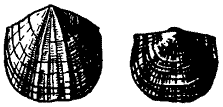
Brachiopoda main page
| Rhynchonelliformea | ||
| Brachiopoda | Billingsellida |
| Metazoa | |||
The Billingsellids are among the most primitive of all articulate brachiopods, and also among the first to appear. Originally included with the Orthids, they have since been placed closer to the Strophomenids. Currently they are included in the Class Strophomenata of the Subphylum Rhynchonelliformea
Classification from Treatise of Invertebrate Paleontology - Part H, Revised - Brachiopoda, and elsewhere

The middle Cambrian saw a new brachiopod lineage appear, the Billingsellidae. The Nisusiidae were previously included with the family Billingsellidae in the superfamily Billingsellacea, but shell structure indicates this is unlikely. The secondary shell of Nisusia is fibrous with a pattern identical to that of modern Terebratulides and rhynchonellides in which the calcite fibres are segregated by protein sheaths. Billingsella in contrast has a laminar secondary shell characteristic of other, quite distinct, groups of articulate brachiopods. This fundamental distinction in forms which morphologically are very similar is puzzling.
The billingsellaceans may form the ancestral stock from which all the subsequent articulate brachiopods are believed to have been derived. The superfamily has conventionally been placed in the Orthida, but is now placed with the Clitambonitidina in a separate order

These persistently primitive articulate brachiopods were previously included in the Orthida, but are now considered closely related to (and probably descended from) the Billingsellidina. Ventral muscle field impressed on spondylium. The socket ridges diverge at a sharp angle, and the chilidium is convex .
They retaining the primitive features of the deltidia and chilidia. Simple spondylia or more rarely pseudospondylia are developed. The shells are impunctate. (Invertebrate Paleontology, 1935 p.291)
There are two superfamilies, the impunctate Clitambonitacea and the pseudopunctate Gonambonitacea, which are also distinguished by the type of radial ornamentation on the surface of the shell
 Brachiopoda main page |